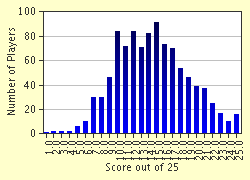Quiz Answer Key and Fun Facts
1. This is probably the most popular type of pasta. Sophia Loren has said that she owes everything she has to it. Rossini used a large plate of it to resolve the plot of his opera "L'Italiana in Algeri" (pasta ex machina?). People often struggle to eat it gracefully; the trick is to twirl it around your fork. What am I talking about?
2. This cut of pasta resembles the writing end of an old fashioned quill pen, hence its name. It is tubular and cut on the diagonal.
3. Another tubular pasta is named for the grooves, or ridges along its sides which help it hold onto the sauce.
4. The name for this pasta translates to "little ears", which they resemble.
5. There are two names for this type of pasta, which consists of very thin hollow tubes. When cooked, they resemble thick spaghetti. One name is bucatini (from the word "buco", meaning hole). What is the other name?
6. Which of the following is NOT a stuffed pasta?
7. This type of spaghetti is handmade on an implement resembling a zither or a box-shaped harp. It has many wires running across. The pasta dough is rolled across and falls through cut into thin strands. What is the name for this type of pasta?
8. This type of pasta is usually made from scraps of dough cut irregularly into triangles. It is principally used in soups. Its name means "badly cut". Which is it?
9. "Little worms" and "little tongues" are the rather unappetizing translations of the names of these two pastas.
10. Of the following, three are types of pasta, the fourth is a name for almond paste. Which one is the odd man out?
11. Gnocchi is a type of dumpling which is usually made from potatoes and flour, but can also be made from rice, ricotta cheese, pumpkin, or even bread crumbs. Or they may be flat discs made from a semolino mixture, layered in a pan, and baked with either a sauce or butter and cheese on top. Which is the name for the traditional potato gnocchi?
12. In what way are tortelloni different from tortellini?
13. Bow-tie pasta is known by this name in Italian, which means "butterflies".
14. Spaghetti and meatballs is the most common pasta dish served in America. If you wanted to order this in Italian, what would you ask for?
15. Ragu is the brand name of an American brand of pasta sauce, not the name of an actual Italian pasta sauce.
16. This sauce is named for the "ladies of the evening". It is quickly prepared and contains tomatoes, peperoncini (small hot peppers), olives, garlic, capers, and anchovies. Which of these is it?
17. This meat sauce is named from its city of origin, which is known for the richness of its cuisine (even though the one seen outside Italy does only remotely resemble the original). It contains meat, tomatoes, and cream and, as traditionally made, is seasoned with cinnamon.
18. Fettuccine Alfredo, created at the restaurant "Alfredo" in Rome, is popular with American tourists. It was created in the early 1900s by chef Alfredo di Lelio for his wife, who had just given birth. It was later served to the American actors Mary Pickford and Douglas Fairbanks; they loved it and it became a favorite of visiting celebrities ever since. American versions of this dish are made with an "Alfredo sauce", containing cream, butter, cheese, egg yolk, etc. However the original dish uses only these two ingredients.
19. Pesto, a green herb sauce from Genoa, has become a "trendy" dressing for pasta in America in the past two decades. What are its traditional ingredients?
20. Pasta served "all' Arrabbiata" is made with a tomato sauce containing this key ingredient.
21. Two kinds of fettuccine, regular egg fettuccine and fettuccine verde (green fettuccine made with spinach) are used to make "Paglia e fieno", a dish containing cream, butter, cheese, and possibly prosciutto. What does the name "paglia e fiene" mean in English?
22. If you wanted linguine with clam sauce, you would ask for this in Italy.
23. If you played my "Italian cuisine, A to Z" quiz, you already know this. What is the name for pasta tossed with egg yolk, pancetta (bacon), grated cheese, and cracked black pepper?
24. Pasta "Aglio e olio" traditionally uses these two ingredients.
25. Cannelloni is a stuffed, tubular pasta; what stuffing and topping is most typically used in Italy?
Source: Author
jouen58
This quiz was reviewed by FunTrivia editor
Bruyere before going online.
Any errors found in FunTrivia content are routinely corrected through our feedback system.

